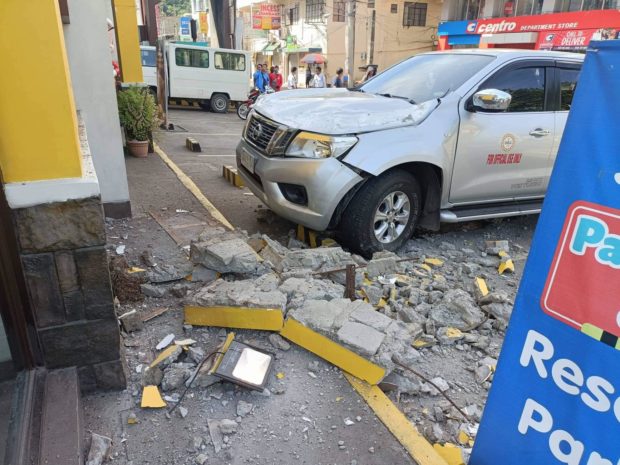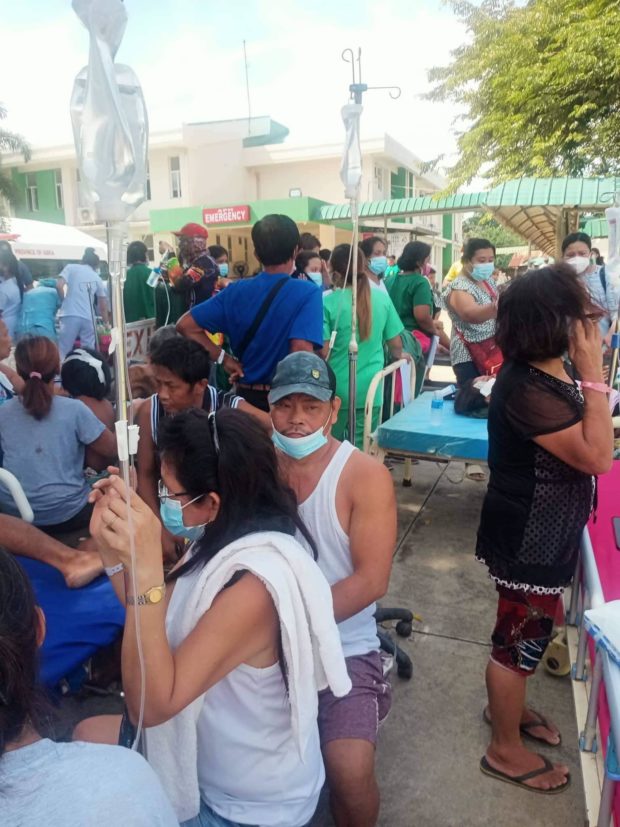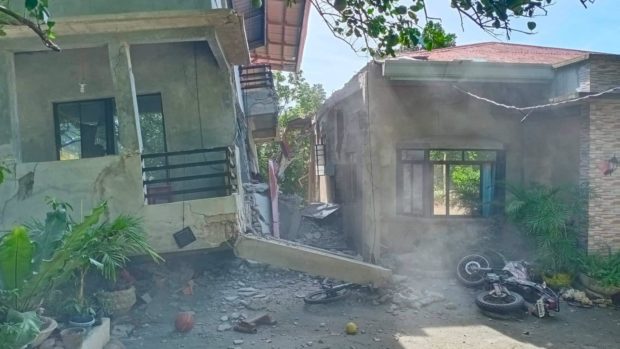Magnitude 7 earthquake jolts Abra, other parts of Luzon
Updated 9:20 a.m., 9:30 a.m., 10:14 a.m.
MANILA, Philippines — A magnitude 7 earthquake struck inland in the northern province of Abra Wednesday morning, killing at least one person and badly damaging buildings and roads, and sending strong tremors through Metro Manila.
The strong quake centered two kilometers northeast of Langilang, Abra, the Philippine Institute of Volcanology and Seismology reported.
Its magnitude was initially placed at 7.3.
A 25-year-old man was killed by falling debris, said Abra Vice Governor Joy Bernos, when the quake struck at 8:43 a.m. at a depth of 25 kilometers.
“Despite the sad reports about the damages caused by the earthquake, we are assuring quick response to those in need and affected by this calamity,” President Ferdinand Marcos Jr said on Facebook.
According to officials, a hospital in Abra was evacuated after the building partially collapsed following the quake, but no casualties were reported.
Bernos posted photos of the damaged Abra hospital on her Facebook account, which showed a gaping hole in its facade.
Other photos showed hospital beds, including one with a patient being wheeled across a road and evacuated hospital staff.
Renato Solidum, director of the state seismology agency, told DZRH radio station, strong aftershocks were expected.
“The focus of attention is on Abra and nearby provinces. This is a major earthquake,” Solidum said, adding that landslides had been reported in some parts of Abra, particularly in the town of Manabo.
Abra, home to nearly 250,000 people, is a landlocked province in the northern Philippines. Rugged mountains enclose its deep valleys and sloping hills.
The Philippines is prone to natural disasters and is located on the seismically active Pacific “Ring of Fire”, a band of volcanoes and fault lines that arcs round the edge of the Pacific Ocean. As a result, earthquakes are frequent and there are an average of 20 typhoons each year, some triggering deadly landslides.
Eric Singson, a congressman in Ilocos Sur province, also in the north, told DZMM radio station the quake had been felt strongly there and lasted 30 seconds or more.
“I thought my house would fall,” said Singson. “Now, we are trying to reach people …. Right now there are aftershocks so we are outside our home.”
The quake damaged heritage buildings in the city of Vigan, known for its old Spanish colonial architecture, on the west coast of Luzon.
Tourist Edison Adducul told the radio he was taking photos of the Bantay Church Bell tower in Vigan when the quake struck, shaking the tower for up to three minutes.
Senator Imee Marcos said several churches were damaged.
“The antique bricks and coral stones fell down from the Bantay Bell Tower,” she said.
The quake was also felt in Metro Manila where several buildings were evacuated, with some people forced to flee from the 30th floor of one building, and the capital region’s metro rail systems were halted at rush hour.
Following are the reported intensities:
- Intensity VII – Bucloc and Manabo, Abra
- Intensity VI – Vigan City, Sinait, Bantay, San Esteban, Ilocos Sur; Laoac, Pangasinan;
Baguio City; - Intensity V – Magsingal and San Juan, Ilocos Sur, Alaminos City and Labrador, Pangasinan;
Bambang, Nueva Vizcaya; Mexico, Pampanga; Concepcion, and Tarlac City, Tarlac;
City of Manila; City of Malabon - Intensity IV – City of Marikina; Quezon City; City of Pasig; City of Valenzuela; City of Tabuk,
Kalinga; Bautista and Malasiqui, Pangasinan; Bayombong and Diadi, Nueva Vizcaya;
Guiguinto, Obando, and San Rafael, Bulacan; San Mateo, Rizal - Intensity III – Bolinao, Pangasinan; Bulakan, Bulacan; Tanay, Rizal
- Intensity II – General Trias City, Cavite; Santa Rosa City, Laguna
Below are the instrumental intensities:
- Intensity VII – Vigan City
- Intensity V – Laoag City, Ilocos Norte; Peñablanca, Cagayan; Dagupan City, Pangasinan;
Sinait, Ilocos Sur; Baguio City - Intensity IV – Gonzaga, Cagayan; Baler, Aurora; Bayombong, Nueva Vizcaya; Ramos, Tarlac;
Ilagan, Isabela; Basista, Pangasinan; Claveria, Cagayan; San Jose, Palayan City and
Cabanatuan City, Nueva Ecija; Madella, Quirino; Tabuk, Kalinga; Santiago City, Isabela - Intensity III – Quezon City; Iba, Zambales; Navotas City, Malabon City, Metro Manila;
Magalang & Guagua Pampanga; Bolinao, Sison & Infanta, Pangasinan; Bulakan, San Ildefonso,
Guiguinto, Plaridel, and Malolos City, Bulacan; Tarlac City, Tarlac - Intensity II – Dona Remedios Trinidad, Angat & Santa Maria, Bulacan; Tagaytay City, Cavite;
Pasig City Metro Manila; Polillo, Gumaca & Infanta, Quezon - Intensity I – Tanay, Taytay, Morong, Antipolo City, Rizal; Marilao,Bulacan; San Juan City,
Las Pinas City, Metro Manila; Lucban, Quezon; Subic, Zambales; Mercedes,Camarines Norte;
Olongapo City, Zambales; Carmona, Cavite
Phivolcs said damage and aftershocks were expected.
Neil Arwin Mercado, INQUIRER.net, Inquirer One Luzon Bureau
RELATED STORY
Are Filipinos prepared for the Big One?

















